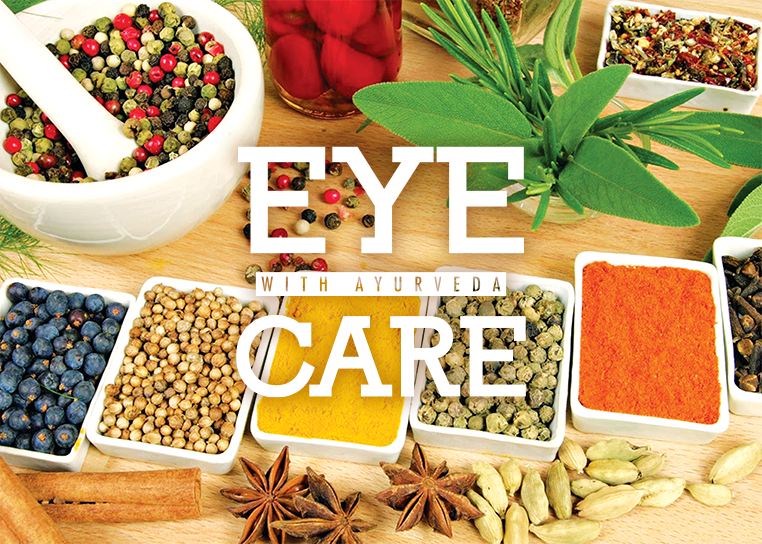Ayurveda greatly emphasizes the con-sumption of wholesome diet (pathya), the rules and principles gover-ning diet (Ahara vidhi). Food is the first pillar that supports life energy. Hence balanced food is advised for total nourishment of the body. Some foods that are beneficial for the eye as mentioned in the Ayurvedic classics are:
1. Cereals – Red rice (oryza sativa), wheat and barley.
2. Pulses – Green gram, soya beans. Ideally the preparation with pulses can be combined with rock salt and plant fat to neutralize vata dosha.
3. Medicinal herbs – boerhavia diffusa, leptadenis retivulate, spinach, momordica, solanum indicum, carrot, coriander, drumstick, unripened banana and radish are some of the vegetables that are specific for eyes.
4. Fruits – grapes, mango, orange, guava, papaya, apple and pomegranate.
Antioxidants are naturally occurring compounds that can protect the body from harmful free radicals, sweeping them up, before they can cause damage.
Many experts believe free radical damage is one of the most prominent causes of devastating diseases such as ocular degenerative disorders, heart disease, cancer. Indeed, the aging inflatable water slide process itself is the result of free radical damage. Eye disease is no exception. Research suggests that certain antioxidants can reduce the risk of cataract, macular degeneration and more. Such factors are:
Green leafy vegetables in Eye care
Green leafy vegetables are rich in vitamins A, C & E (Antioxidants) and many are good sources of Iron, Calcium and other micronutrients as well. Blue region of the visible light is the most damaging wavelengths of light to which the retina is routinely exposed, that may cause damage to the macula, that creates the sharpest vision. Antioxidants rich in the green leafy vegetables are recognized as key factors in maintaining the macula.
In Ayurveda, the importance of consumping green leafy vegetables in everyday diet has been emphasized. Some important vegetables are – carrot, radish, curry leaves, coriander, garlic etc.
Vitamin A and eyesight
The relationship between vitamin A and eye health is quite popular and the ancient texts substantiate the same. Vision is a complex process that requires numerous components of the human eye and brain to work together.
The photosensitive compound in the retina is a protein called ‘Rhodopsin’ in which vitamin A is present. This complex plays the important role in light perception and thus in vision. Vitamin A aids in maintaining good night vision and day-to-day vision. The earliest symptoms of vitamin A deficiency are xerosis, bitot’s spot, night blindness, keratomalacia etc.
Where do I get my vitamin A?
Vitamin A is present in two forms. Active or pre-formed vitamin A is called retinol, and is available in animal products like – milk, ghee and cheese. Inactive or pro vitamin is beta carotene, some of which will be converted into retinol in the intestinal mucosa, and is present in plant sources – carrot, spinach, amaranth, fenugreek, curry leaf, drumstick, tomato, pumpkin, ripen papaya and mango and more.
Amino acids in eye care
People with diabetes are under high risk for the complication of the eyes namely diabetic retinopathy and cataract. Dietary amino acids can prevent/control these ocular diseases by preventing the excess glucose in damaging the lens and the retina of the eye. Scientists have found that free amino acids have significant anti-diabetic effects when supplemented orally to patients with diabetes.
Essential amino acids (EAA) must be obtained from dietary proteins because the body can’t synthesize in amounts corresponding to its need. The important aspect is that new tissues can’t be formed unless all the EAA are present in the diet. A protein is said to be biologically complete if it contains all EAA in amounts corresponding to human need.
Where do I get my amino acids?
The sources include nuts (peanuts), seeds (almonds), pulses (green gram, Bengal gram etc.), soya products, cereals (wheat, oats and rice), eggs and some inflatable slide diary products. A combination of many of these in your everyday food meets the demands. The nutritional quality of soya bean is superior as it contains more protein and is also a good source of iron and calcium.
When two different foods are combined, the amino acids in one protein can compensate for the one lacking in the other. This is known as protein complementing. Rice and Dal, peas on toast, peanut butter sandwich, rice with beans are all examples of protein complementing.
…(more)
To read the full article please download our Asana Journal App or purchase Issue 170 February 2017.





















 Other
Other